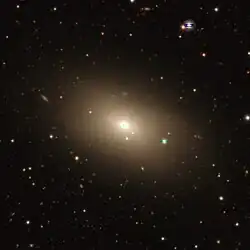| NGC 7029 | |
|---|---|
 The elliptical galaxy NGC 7029. | |
| Observation data (J2000 epoch) | |
| Constellation | Indus |
| Right ascension | 21h 11m 52.0s[1] |
| Declination | −49° 17′ 01″[1] |
| Redshift | 0.009470[1] |
| Heliocentric radial velocity | 2,839 km/s[1] |
| Distance | 118.7 Mly |
| Apparent magnitude (V) | 12.35[1] |
| Characteristics | |
| Type | E6[1] |
| Size | ~128,979.48 ly [1] |
| Apparent size (V) | 2.6 x 1.4[1] |
| Other designations | |
| ESO 235-72, AM 2112-483, PGC 66318 [1] | |
NGC 7029 is an elliptical galaxy located about 120 million light-years away from Earth in the constellation Indus.[2][3] NGC 7029 has an estimated diameter of 129,000 light-years.[3] It was discovered by astronomer John Herschel on October 10, 1834.[4] It is in a pair of galaxies with NGC 7022.[5]
One supernova has been observed in NGC 7029: SN 2023qov (type Ia, mag. 17.5).[6]
Group Membership
NGC 7029 is part of the Indus Triplet of galaxies which contains the galaxies NGC 7041 and NGC 7049.[7]
See also
References
- 1 2 3 4 5 6 7 8 9 "NASA/IPAC Extragalactic Database". Results for NGC 7029. Retrieved 2017-06-09.
- ↑ Rojas, Sebastián García. "Galaxy NGC 7029 – Galaxy in Indus Constellation · Deep Sky Objects Browser". DSO Browser. Retrieved 2017-06-09.
- 1 2 "Your NED Search Results". ned.ipac.caltech.edu. Retrieved 2017-06-09.
- ↑ "New General Catalog Objects: NGC 7000 – 7049". cseligman.com. Retrieved 2017-06-08.
- ↑ "Detailed Object Classifications". ned.ipac.caltech.edu. Retrieved 2017-09-03.
- ↑ Transient Name Server entry for SN 2023qov. Retrieved 23 August 2023.
- ↑ "NGC 7049, an unusual galaxy in Indus". Anne's Astronomy News (in Dutch). 2012-08-05. Retrieved 2017-06-09.
External links
Wikimedia Commons has media related to NGC 7029.
- NGC 7029 on WikiSky: DSS2, SDSS, GALEX, IRAS, Hydrogen α, X-Ray, Astrophoto, Sky Map, Articles and images
This article is issued from Wikipedia. The text is licensed under Creative Commons - Attribution - Sharealike. Additional terms may apply for the media files.